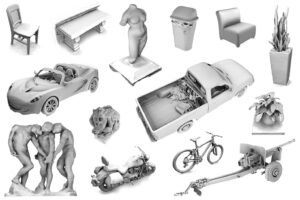
Best Python Libraries for 3D Machine Learning
3D Machine Learning: One of the most researched topics that has received much attention in recent years.
The combination of machine learning, computer vision, and computer graphics is what completes a 3D machine learning model.
The term “3D machine learning” has become popular due to recent research in areas such as self-driving cars, augmented reality, virtual reality, and autonomous robots. The main goal of 3D machine learning is not to analyze just one model, but to analyze the entire ensemble of these models using maps or correspondence and computational alignment, etc.
For a better understanding, we’ll look at some 3D models.
3D Object Detection:
This is a contribution to the PASCAL3D + (2014) dataset, a challenging dataset for 3D object detection and gesture estimation.
These methods have gained popularity because they can easily control uncertainty even in 2D images to provide better descriptions of objects compared to 2D sensors.
Compared to existing 3D datasets, PASCAL3D + images provide better variability.
A total of 12 categories, each providing an average of 3K + objects for 3D object detection and gesture estimation.
Huge scanned dataset:
Created a dataset of over ten thousand 3D scans of real objects. About 70 operators with user-portable 3D scanning installations were asked to scan objects of their choice in their environment without any supervision from a computer vision professional. As a result, there is a large and diverse collection of objects – toys, plush pianos, shoes, mugs, vases, and construction vehicles, among others. This task is performed with the help of lawyers to ensure that data collection is not subject to any kind of privacy restrictions. This dataset, along with the reconstructed model and RGB-D scans, is publicly available for proper use.

A total of 10k RGBD scans and reconstructed 3D models were performed in .PLY format.
If you dig deeper, you’ll find several other pieces of information about 3D machine learning models, such as ABC: Big Data Sets of CAD Models for Deep Geometric Learning, ShapeNet, and Semantic3D, among others.
Well, creating such a model would not be possible without the support of Python libraries. Let’s talk more about the best Python libraries for 3D machine learning.
1. Panda 3D
An open source library dedicated to 3D games, simulations and visualizations. This library is written in C ++ and Python bindings and looks after glossy maps, custom maps, toon and ink coloring, HDR, and more.
Best features:
- Cross-platform machine that simplifies deployment on most supported platforms.
- It also incorporates command line tools that help in optimizing and processing source assets.
- Combining C ++ and Python allows you to develop faster without sacrificing performance.
Stars on GitHub – 2.3k
2. PyTorch3D:
Another open source library for deep 3D learning. It is highly optimized and highly modular, specifically designed to make 3D deep learning easier using the PyTorch library. Facebook AI research uses the library to drive research projects like M-R-CNN.
Top Features:
- Provides data structures to help store and manipulate triangle meshes.
- PyTorch3D provides differential mesh rendering.
- Backed by a host of cloud platforms that provide easy scalability and friction-free development.
Stars on GitHub – 3.4k
3. Open3D:
An open source library well suited for 3D data processing, it also supports the rapid development of software for 3D data processing. The front end of Open3D is featured in a select set of data structures and algorithms, in C ++ and Python. However, the backend is highly optimized and set up for parallelization.
Best features:
- 3D imaging
- 3D Data Processing Algorithms
- 3D data structures
- Physical Rendering (PBR)
- Recreate a scene
Stars on GitHub – 3.1k
4. Mayavi:
A cross-platform tool for visualizing 3D scientific data. It is open source and written entirely in the Python language. Mayavi provides a clean scripting interface for simple and interactive 3D data visualization. In addition to a clean scripting interface, the library provides an object-oriented, one-liner programming interface, and many other features.
Top Features:
- Provides easy extensibility with modules, custom sources, and data filters.
- It helps to read many file formats, including PLOT3D and VTK (traditional and XML).
- Save rendered images in multiple image formats.
Stars on GitHub – 747
5. pi3d:
It is a Python module designed to simplify 3D writing in the Python language, while also allowing them to access the Raspberry Pi GPU. Pi3d enables easy 2D and 3D rendering, while providing access to multiple commands from the host to load animated and textured models, create shaders and fractal landscapes, and more.
Best features:
- Besides the Raspberry Pi GPU, pi3d also runs fine on Linux with X or Windows server with
- Pygame and Android with python for android.
- Pi3d provides compatibility features in Python 2 and Python 3.
Tag:3D MACHINE, LEARNING, LIBRARIES, PYTHON



